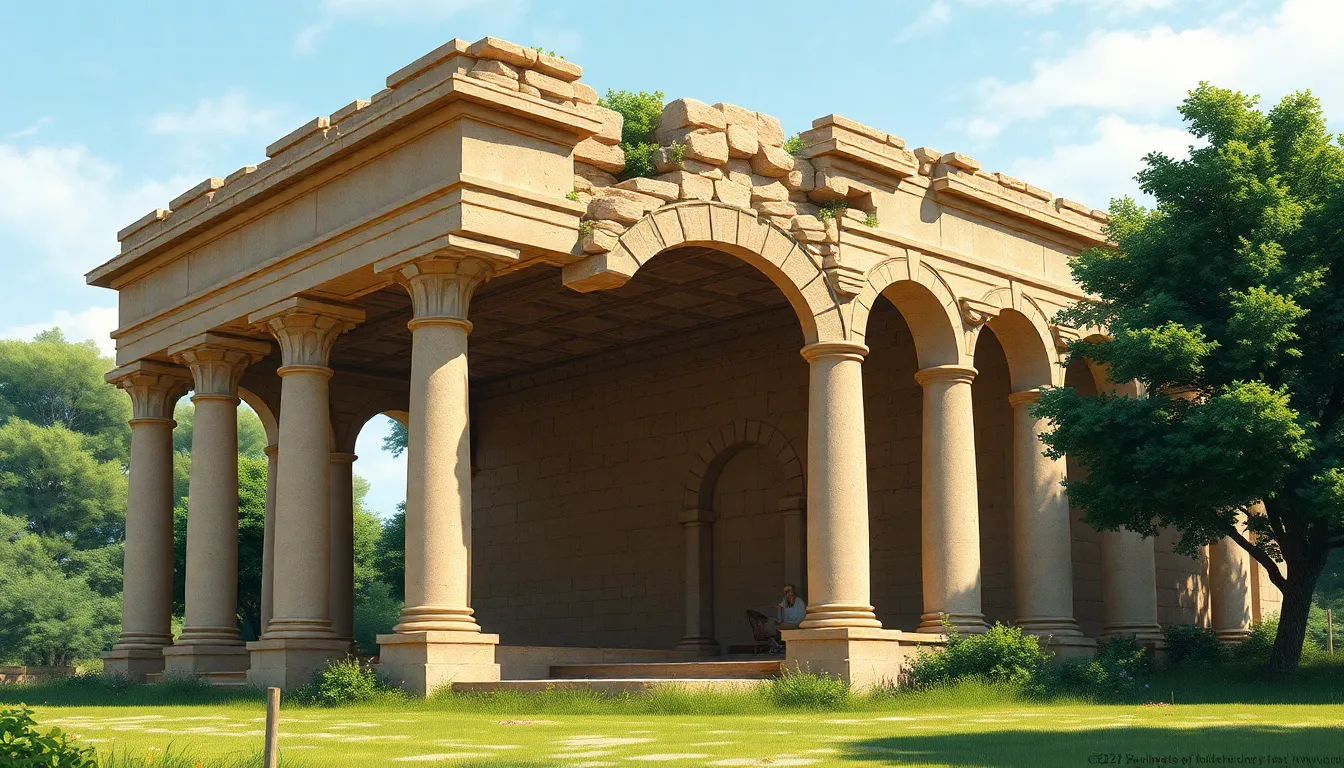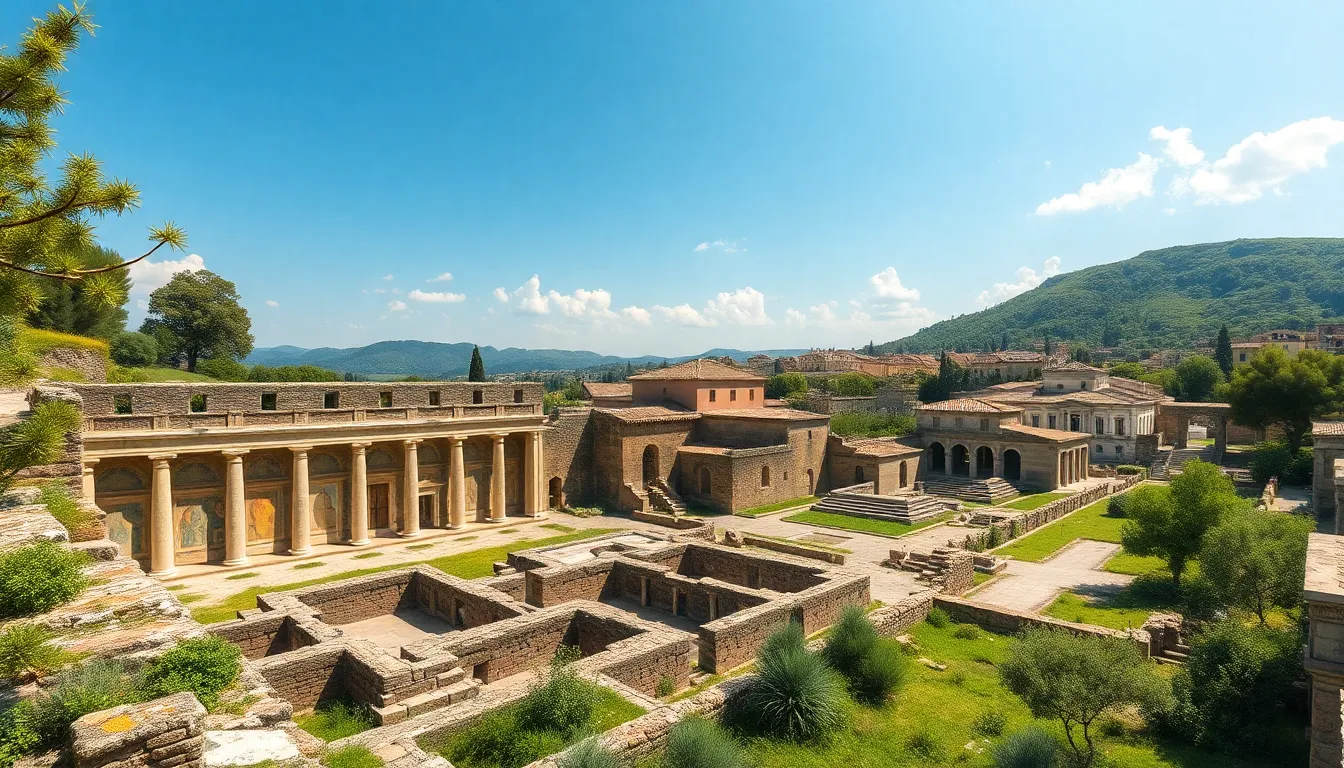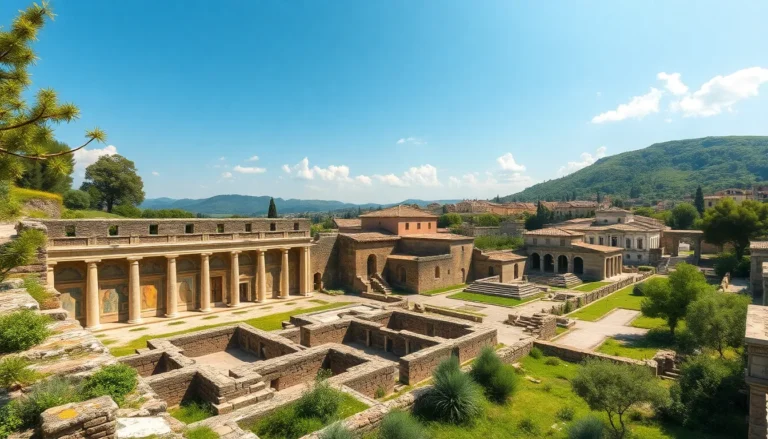Etruscan architecture might not be the first thing that pops into mind when thinking about ancient civilizations, but it’s time to change that! Picture a world where sophisticated urban planning meets stunning tombs adorned with vibrant frescoes. The Etruscans, those enigmatic folks who lived in Italy before the Romans, left behind a treasure trove of architectural wonders that are just waiting to be explored.
Table of Contents
ToggleOverview of Etruscan Architecture
Etruscan architecture displays significant advancements that shaped urban development in ancient Italy. The Etruscans utilized local materials like tuff, clay, and timber, allowing for a distinctive architectural style. They built cities with well-planned layouts, featuring grid patterns that influenced Roman urban planning.
Tombs highlight Etruscan architectural achievements. The elaborate burial sites, often carved directly into rock, showcase intricate designs and colorful frescoes. Such burial chambers provide insights into Etruscan beliefs about the afterlife and reflect their artistic prowess.
Temple structures, characterized by their raised platforms and columned entrances, dominate Etruscan religious architecture. These temples often displayed a mix of Greek and indigenous styles, emphasizing symmetry and proportion. Notable examples include the temples at Veii and Tarquinia, which served as central places of worship.
Infrastructure also played a crucial role. The Etruscans constructed advanced drainage systems, roads, and bridges, enhancing connectivity across their cities. These innovations facilitated trade and interaction with neighboring cultures.
Overall, Etruscan architecture exemplifies a unique synthesis of practicality and artistry. Its influence is evident in subsequent Roman architectural developments, underscoring the Etruscans’ vital contribution to ancient engineering and aesthetics.
Key Characteristics of Etruscan Architecture

Etruscan architecture showcases distinctive features that reflect the civilization’s ingenuity and aesthetic values. Notable characteristics include the innovative use of structures, materials, and techniques that contributed to their unique architectural legacy.
Use of Arches and Vaults
Etruscans pioneered the use of arches and vaults in construction, techniques that enhanced architectural stability and aesthetics. Arches, typically made from stone, allowed for broader spans in buildings, while vaults created expansive interior spaces in temples and other structures. These innovations provided structural integrity and also served decorative purposes, leading to an enduring influence on subsequent Roman architecture.
Material and Construction Techniques
Etruscans predominantly utilized local materials like tuff, clay, and timber, which facilitated sustainable and practical building practices. They employed a technique called “opus incertum,” which involved irregularly shaped stones arranged in a concrete matrix. The result was durable and visually appealing walls. Etruscan builders also embraced advanced drainage systems, ensuring functional urban layouts, and contributing significantly to the longevity of their structures.
Major Etruscan Architectural Sites
Etruscan architecture boasts remarkable sites that illuminate the sophistication of this ancient civilization.
The Tombs of Tarquinia
The Tombs of Tarquinia serve as a testament to Etruscan funerary practices and artistic skill. Dating back to the 7th century BCE, these burial sites feature vibrant frescoes depicting lively scenes of daily life, mythology, and rituals. The most notable tombs, like the Tomb of the Diver and the Tomb of the Anina, showcase complex designs, multi-chamber layouts, and detailed paintings on the walls and ceilings. These artworks provide insight into Etruscan beliefs about the afterlife and their understanding of human experience. The site’s UNESCO World Heritage designation highlights its cultural significance and contribution to the study of ancient art and architecture.
The Etruscan City of Cerveteri
The Etruscan city of Cerveteri, known as Caere, exemplifies advanced urban planning in the Etruscan era. The site features a sprawling necropolis filled with thousands of well-preserved tombs, including the monumental Banditaccia necropolis. Tombs exhibit a range of architectural styles, often resembling homes, reflecting the Etruscan emphasis on life’s continuity after death. Additionally, remnants of urban structures, road layouts, and defensive walls reveal insights into city organization and everyday life. UNESCO recognizes Cerveteri as a World Heritage Site, underlining its importance in understanding Etruscan civilization and architecture.
Etruscan Influence on Roman Architecture
Etruscan architecture significantly influenced Roman architectural practices. This influence is evident in various structural elements, urban designs, and materials adopted by the Romans.
Etruscans pioneered the use of the arch, providing stability and aesthetic appeal in their structures. Romans embraced this innovation, incorporating arches into bridges and aqueducts, enhancing their monumental architecture.
Etruscan temples introduced features such as raised platforms and frontal porches, which transitioned into Roman temple designs. For instance, the Temple of Jupiter on the Capitoline Hill mirrors Etruscan architectural principles, emphasizing the importance of religious spaces.
Urban planning exemplifies Etruscan influence. The grid layout of Etruscan cities like Veii set a precedent for Roman town planning. Romans adopted this organized structure, leading to efficient city layouts in their burgeoning empire.
Materials also played a crucial role in this architectural evolution. Etruscan builders utilized tuff, clay, and timber, laying the groundwork for the durable constructions exhibited in later Roman architecture. Romans expanded on these materials, integrating concrete into their building methods for larger and more complex structures.
Notably, Etruscan decorative elements, like vibrant frescoes and intricate terracotta work, found their way into Roman aesthetics. These influences shaped public buildings, private homes, and tomb art, reflecting societal values and beliefs.
The adaptation of Etruscan architectural techniques and styles laid a foundation for Roman architectural achievements, serving as a bridge between these two influential ancient cultures. The Romans’ advancements drew directly from Etruscan innovations, leading to a rich architectural legacy that shaped urban landscapes and construction practices in ancient Italy and beyond.
Etruscan architecture stands as a testament to the ingenuity and artistic vision of an ancient civilization. Its influence on urban planning and construction techniques laid the groundwork for future architectural advancements. The intricate designs of Etruscan tombs and temples not only reflect their beliefs and values but also showcase a unique blend of practicality and beauty. As modern society continues to explore its historical roots, the architectural legacy of the Etruscans remains an essential chapter in the story of human creativity and innovation. Appreciating this remarkable heritage enriches our understanding of ancient cultures and their lasting impact on architecture today.




